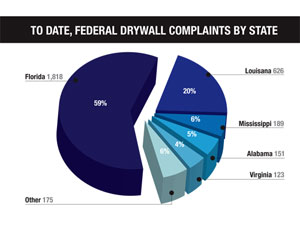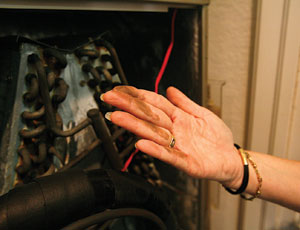The warning shot came in a federal court in Louisiana, and it may signal the beginning of the end of one more costly aspect of the homebuilding boom of 2004-2007. Federal Judge Eldon Fallon in New Orleans ordered Taishan Gypsum Co. Ltd. to pay seven Virginia families a total of $2.6 million to remediate defective Chinese-made drywall in their homes. The case is the first of several class-action lawsuits filed against manufacturers of material that has proven to be a veritable nightmare—and source of odors—for thousands of home-owners.
The case is considered a bellwether for the other suits against the manufacturers of defective Chinese drywall because the same court is hearing all the cases.
“The message Judge Fallon’s ruling sends to thousands of other homeowners who have been victimized is that help is finally coming—they will be made whole after the ravages of inferior Chinese drywall and will not have to bear the substantial costs of repairing their homes to get rid of it,” says Christopher Seeger, a New York lawyer who represented the Virginia homeowners in the Taishan case.
A ruling is expected in the coming weeks in the second case, in which Florida homeowners sued German-owned Knauf Plasterboard Tianjin.
The $2.6-million award is welcome news not just for the Taishan-case homeowners, who typically couldn’t collect under their insurance policies, but for builders who want to get involved in remediation efforts but who have not been able to obtain financing to pay for it. As a result, some builders have had to leave the material in place.
“Looking at the U.S. economy, this could not have happened at a worse time,” says Jenna Hamilton, assistant vice president of government affairs at the National Association of Home Builders. “Builders simply don’t have cash on hand.”
But industry sources agree significant remediation opportunities are still ahead for firms that perform demolition or specialty trade work for homes and condominiums. According to the U.S. Consumer Product Safety Commission (CPSC), residents in 37 states, Washington, D.C., American Samoa and Puerto Rico have filed approximately 3,000 reports of defective drywall in their homes. Most of it was installed during the wave of new building after the major hurricanes in the Southeastern United States between 2005 and 2007, with most of the cases concentrated in Florida, Virginia and Louisiana.
“Most of the problems are going to be occurring near the ports where they brought in [the defective drywall],” says Ron E. Wright, a building diagnostic expert and chief operating officer of Buric, a claims consultant with an office in Wilmington, N.C. Wright testified as an expert witness in the Taishan case.
NAHB’s Hamilton says many homebuilders have been waiting for clear guidance from CPSC on how to remediate homes with problem drywall. CPSC recently gave them something to work with, issuing interim guidance on April 2. The three-page document instructs homeowners to remove “all possible problem drywall” and replace electrical component and wiring, gas-service piping and fire-suppression sprinkler systems as well as smoke alarms and carbon-monoxide alarms. The guidance does not address air-handling HVAC systems or leaking or corroded...





Post a comment to this article
Report Abusive Comment